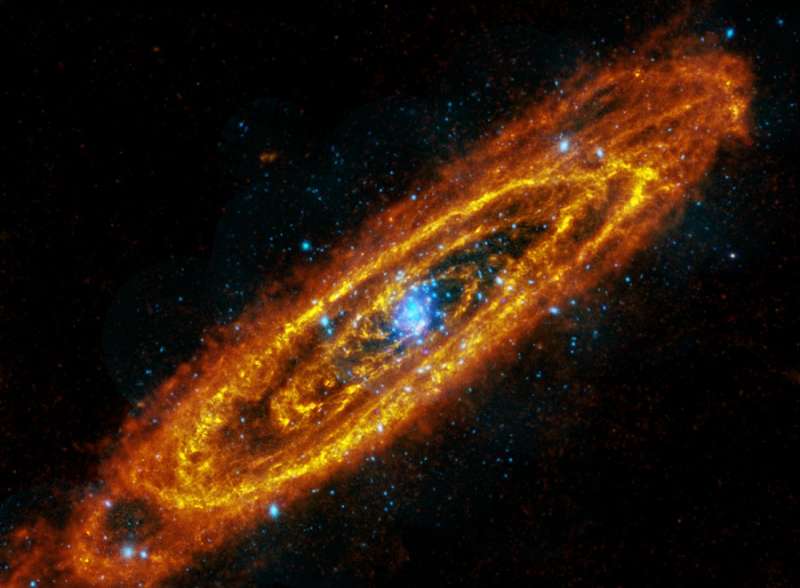
|
Credit & Copyright:
Credit and Copyright: ESA/Herschel/ PACS/SPIRE/J.Fritz(U.Gent) / XMM-Newton/EPIC/W.Pietsch(MPE)
Explanation:
The big, beautiful Andromeda Galaxy,
aka M31, is a spiral galaxy a
mere 2.5 million light-years away.
Two space-based observatories have combined to produce
this intriguing composite image of Andromeda,
at wavelengths outside the
visible spectrum.
The remarkable view
follows the locations of this galaxy's
once and future stars.
In reddish hues, image data from the large
Herschel infrared
observatory traces enormous lanes of dust,
warmed by stars, sweeping along Andromeda's spiral arms.
The dust, in conjunction with the galaxy's interstellar gas,
comprises the raw material for future
star formation.
X-ray data from the XMM-Newton
observatory in blue
pinpoint Andromeda's X-ray binary
star systems.
These systems likely contain neutron stars or stellar mass
black holes that represent final stages in stellar evolution.
More than twice the size of our own Milky Way,
the Andromeda Galaxy is over 200,000 light-years across.
Credit and Copyright: ESA/Herschel/ PACS/SPIRE/J.Fritz(U.Gent) / XMM-Newton/EPIC/W.Pietsch(MPE)
|
January February March April May June July August September October November December |
| |||||||||||||||||||||||||||||||||||||||||||||||||||||||
NASA Web Site Statements, Warnings, and Disclaimers
NASA Official: Jay Norris. Specific rights apply.
A service of: LHEA at NASA / GSFC
& Michigan Tech. U.
Based on Astronomy Picture
Of the Day
Publications with keywords: M 31 - Andromeda galaxy - infrared - X-ray - stellar evolution
Publications with words: M 31 - Andromeda galaxy - infrared - X-ray - stellar evolution
See also:
- APOD: 2025 February 23 Б Saturn in Infrared from Cassini
- Hubble s Andromeda Galaxy Mosaic
- NGC 206 and the Star Clouds of Andromeda
- APOD: 2024 September 8 Б M31: The Andromeda Galaxy
- APOD: 2023 November 13 Б Andromeda over the Alps
- The Once and Future Stars of Andromeda
- APOD: 2023 August 23 Б The Meteor and the Galaxy
